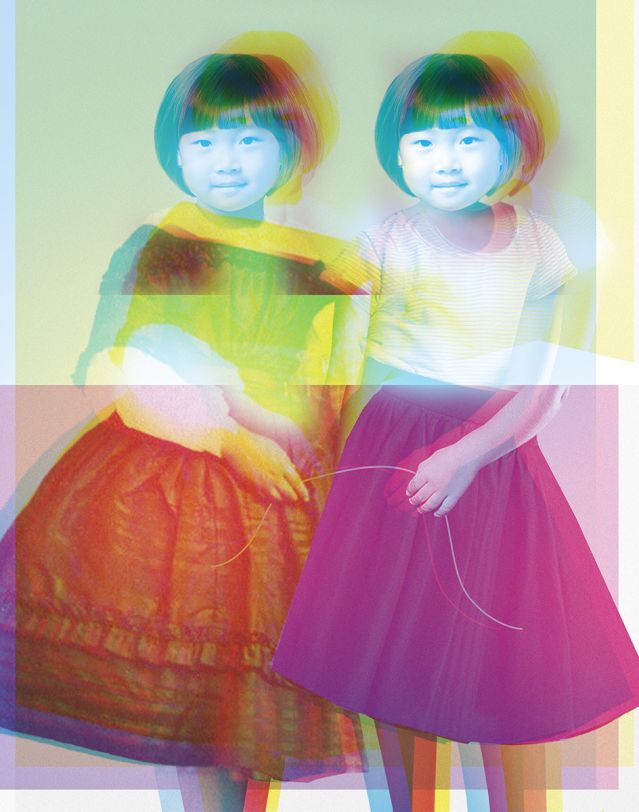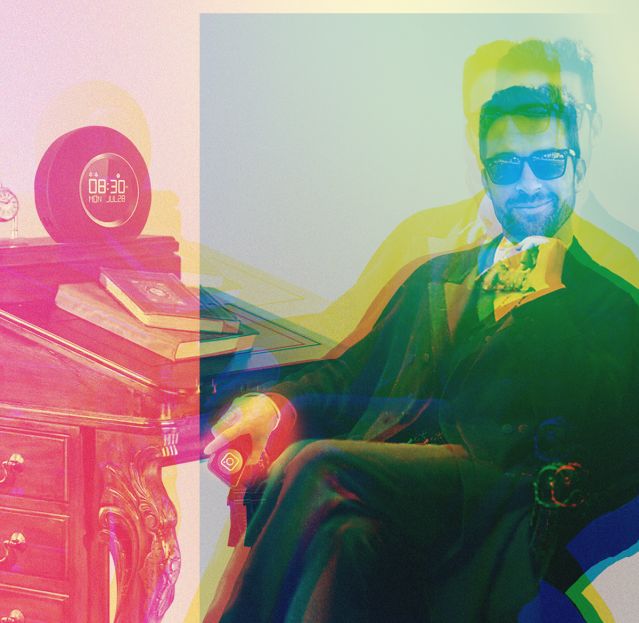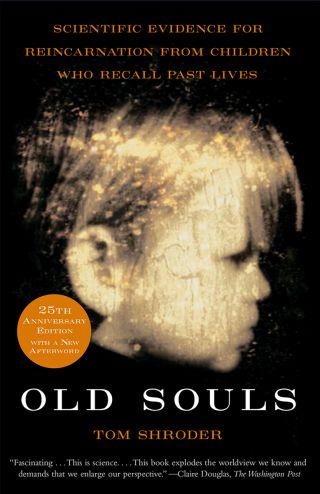Familiar Strangers
If these bizarre incidents weren’t random coincidences, what were they?
By Tom Shroder published July 2, 2024 - last reviewed on July 14, 2024

A few months ago, a message popped into my inbox. It was from an 80-year-old man born in Lebanon and now living in the United States. When he was 3 or 4 years old, he wrote, he started telling his mother that in a previous life he had been killed by two men dressed in black, leaving behind a wife and children he missed and was desperate to see again.
He remembered his death in his past life vividly, he wrote. His two young sons were playing in a neighborhood playground while he ate lunch with his wife on the nearby veranda of his house. Suddenly, he heard his boys screaming. He swallowed a bite of the cucumber he’d been eating and ran to the playground. Two much older kids sat astride his prone boys pummeling them with their fists. He tore the older kids off his sons and threw them to the ground. As he walked back to his house with his still crying sons, two men wearing long black robes attacked him from behind. As one man held his hands, the other pulled a long knife and stabbed him in the left side of his abdomen. Blood poured out onto the ground. The man kept thrusting the knife into him until he collapsed, still conscious. He was aware of the men picking him up and throwing him into blackberry brambles. His last sensation was of the thorns tearing his back.
He claimed his memories were specific enough to clearly identify his past family, who heard about his statements and came to see him, confirming the details he had given about the murder. “I do not believe that I am crazy,” he wrote. “Now I want to ask you a question: Personally, do you accept and believe the theory of reincarnation?”
In the quarter century since the publication of my book Old Souls, which recounted my investigations of dozens of cases of small children who talk about previous lives, I have been asked that question hundreds of times. I’ve never known exactly how to answer it.
The cases I investigated—in Lebanon, India, and the United States—were undeniably impressive. One was that of a little girl outside Beirut who, before she could form full sentences, would pull the phone off the hook and desperately attempt to call her “husband.” She named the husband and seven children, in order of birth. The little girl’s parents said she gave them enough information to pinpoint the family she was describing, who’d lost a wife and mother in a botched heart surgery shortly before the girl had been born.
Two sisters of that family, by then adults, heard about the girl’s claims and, skeptical, made a surprise visit to test her. They said that as soon as the girl saw them she called them by name and said, “You’ve come!” And one of the first things she asked was if their uncle had given them her jewelry, as she’d requested. This persuaded the sisters that the girl’s claim was genuine: Only their inner family knew that as their mother awaited the fatal surgery, she’d asked her brothers to distribute particular pieces of jewelry to each of her daughters.
After personally witnessing dozens of similar cases, I came to feel that imagining a “normal” explanation for every one of them—such as fraud, delusion, faulty memory, wishful thinking, mental illness, or meaningless coincidence—became more difficult than facing the possibility that an unknown force was at work. I believe the subjects in these accounts were sincere, sane, and honest.
In the search for truth, I have always had one bedrock belief: The closest we can get to knowing anything is through testable, reproducible empirical evidence. And here was the problem: My firm belief that if there is such a thing as reincarnation, it must be made possible by the physical laws of nature and should, in principle, be demonstrable through empirical evidence.
Well-researched case reports are a type of empirical evidence, yes. And in the quarter century since I started thinking about this, there has been no shortage of new cases reported. In fact, they do not seem to be all that rare. In late 2022, Washington Post reporter Caitlin Gibson solicited stories from parents about spooky things their kids had said. Of the 31 responses collected for the story, eight referenced previous lives. One submission concerned a small child who periodically mentioned his “other mom and dad” and a few more vague details of his “other” life. Then while driving through a city he’d never seen, the boy suddenly shouted, “We all died in a fire in a building that looked like that one!” Another report came from a mom who recounted walking through her neighborhood with her kindergartner, who inexplicably demanded to be taken to her “other house.” When asked what house, the girl said, “The blue one, the one with the cats,” and pointed up the street. When the woman got home, she relayed the puzzling comment to her husband, who shocked her by saying his long-dead grandmother had lived in a blue house up the street that had burned down years earlier. And she’d always filled the house with cats.
Perhaps the most famous is the case of James Leininger of Houston, Texas. James’s parents, who told his story in a book and on television appearances, claimed that in the early 2000s when he was just 2 years old, playing with a model WWII-era fighter plane, his mother mentioned the “bomb” protruding from the bottom of the plane. James corrected her, saying it was a “dwop tank,” not a bomb. His parents looked up the plane, and were astonished to learn that their little son was absolutely correct, if somewhat phonetically challenged—the protrusion was a “drop tank” for spare fuel. Soon after, James began to wake up with nightmares, crying out, “Airplane crash! Plane on fire! Little man can’t get out!” Over the next couple of years, he gradually gave specifics of an apparent combat death and some surrounding circumstances. He said he flew his plane off a boat called Natoma, that he had a friend on the Natoma named Jack Larsen, and his own name had been James. He was constantly drawing pictures of planes and boats, signing them “James 3.” He explained cryptically that this was because he was “the third James.” When James was 2½, he noticed his father looking through a book on the 1945 battle of Iwo Jima. James pointed to an aerial photograph of Iwo Jima’s Mt. Suribachi and said, “That’s where my plane was shot down.” Both fascinated and a little creeped out, James’ father began to research these claims. Many seemed to be corroborated. An aircraft carrier named Natoma Bay had participated in the battle of Iwo Jima. A Jack Larsen had served on the Natoma Bay. And the only pilot from the Natoma Bay who was lost during the battle of Iwo Jima was a 21-year-old named James M. Huston, Jr. That lent a spooky credence to the James 3 signature: The lost pilot would be the second James, the first being James Junior’s dad, James, Sr. His son would be James 3.

Overall, the Leininger story has the features of the most persuasive cases I investigated—a small child spontaneously making detailed and later verified statements about a dead stranger’s life. However, it does no more than any of them to suggest a plausible mechanism for how the personality and memories of a human being could somehow not only survive death but be transplanted into another person days, weeks, months or, as in James’s case, many years after the brain that contained them had turned to ash.
In fact, support for the belief in an ethereal, transcendent self that could conceivably be transferred from one person to another kept getting worse. About a decade ago, Cornell neuroscientists used functional magnetic resonance imaging (fMRI) scans to observe the physical changes in the brains of test subjects who were instructed to think about a specific person. Simply by observing variations in blood flow to different parts of the brain, they could determine which of several people the subject was thinking of. It began to seem that no matter how deeply scientists delved into the brain and nervous system, all they would ever find were organic molecules and cellular structures communicating through chemical reactions—cause and effect, actions and reactions that ultimately could explain everything that humans think and do, and pretty much rule out the possibility of reincarnation.
When I got the email from the man who remembered being murdered in a previous life and demanded to know if I believed in reincarnation, I responded with a condensed version of what I have written here, and he messaged back: “I appreciate the way you illustrated to me that researchers and psychiatrists cannot say that reincarnation is a theory they can prove.…But excuse me if I say I don’t care what researchers and psychiatrists say…because down deep in my heart I know I remember my previous life.” He had me.
From the outside, everything he says about his past life memories is suspect. It has to be, because everything we can observe, measure, or test says a past life is impossible. So, we examine his motives for making the claim—but they can never be known for certain. We note that his memories of accurately recounting details of his past life as a child are unreliable as all memory is notoriously unreliable. We question eyewitness corroboration he might have, because witnesses so often get it wrong, delude themselves, or lie.
But from the inside, it’s a different story. He knows what he remembers, he knows his only motivation is the truth of his experience. He doesn’t need witness corroboration because he witnessed it himself. I can’t know that, but he does.
I understand his frustration.
”Because deep down in my heart...” That’s what got me.
It made me think of an extraordinarily strange experience I had in the Arizona desert many years ago. I was young, uncertain about what to do with my life, and constantly agonizing about it. Driving around the country in a broken-down Datsun with my close friend, we discussed and dissected our dilemma endlessly. Should we follow the safe, expected path—go home, get jobs, settle down—or keep roaming, strike out into the unknown, and take the risky, adventurous route? Being men in our early 20s, we of course also connected our fates with various women in our lives—the “safe” one versus the “wild” one. And it being the mid-1970s, we associated each with a particular rock song. In my case, the “wild” option was represented by Bruce Springsteen wailing “She’s the One,” which we must have listened to more than a hundred times on the tape deck in the weeks it took for us to wend our way from the East Coast to a campsite in a deserted campground just south of the Grand Canyon. This self-obsession was as nauseating as it sounds, but to us at the time it was deadly serious.
We pitched our tent late at night; the campground was down a long dirt access trail, and we were the only ones there, in the furthest possible spot from the paved road. Once again, as we fell into debate about what we saw as the stark choice before us, my anxiety returned and intensified to an unbearable pitch. At some point after midnight, I just couldn’t take it anymore. “To hell with this,” I said, “I’ll just wait for a sign,” and fell silent.
Not more than 30 seconds later, a flash of headlights brushed the tree trunks along the trail, followed by the rumble of an engine, a van. It kept coming, past maybe 50 empty campsites, then stopped at the site immediately next to ours. The side door slid open and from within a tape player blared a song: “She’s the One.” It ripped off mid-verse, the lights switched off, the door slammed shut, and we neither saw nor heard anything more from the now dark and silent van.
I had asked for a sign and within seconds a sign was delivered out of the empty darkness, a sign so exactly specific to my thoughts, and so unlikely to pop up in the middle of the night in the middle of a wilderness campground, that in the decades since, I have simply been unable to accept the commonsense explanation, which is that although it was a one-in-a-billion situation, it did not require any strange phenomena to happen. It only required that someone drive up in a van near where I was camping and put on Springsteen.
And that is eminently reasonable, for any outside observer.
No outside observer could be certain that I hadn’t unconsciously embellished the memory over the years. Nobody else could know—as I knew—how unique the circumstances were, how intense the emotions that had led me to say and mean something I’d never said seriously before: “I’ll wait for a sign.” What investigator could be sure that I wasn’t embellishing or cherry-picking the circumstances?
But I could be sure, and I was. Almost half a century after the fact, I called the only other person who could attest to all the above, my friend David, who had been standing beside me in that campground. He remembered things happening exactly as I did. I asked him, “So how do you account for it.”
He said, “The law of big numbers. What happened was a one-in-a-billion shot, but there are billions of moments in your life, so it’s not unlikely that in one of those billions of moments, a one-in-a-billion coincidence would occur, purely by chance.”
Agreed. But the thing is, there haven’t been billions of moments like that one. There have been exactly two times in my life when, feeling so overwhelmed, so exhausted by emotional confusion, it came to me to just say, “Enough! I’ll wait for a sign,” and mean it.
Here’s the second time it happened. I’d met a woman at a three-day professional convention, by the end of which I thought I wanted to spend the rest of my life with her. Three days. I was old enough and experienced enough to know how crazy that seemed. As we parted in the airport, heading for different flights to opposite ends of the country, I was tortured by uncertainty, not about how I felt, but about whether the feeling was real or the projection of some romantic fantasy. And if it was real, what should I do about it? We both had careers, friends, and homes, 1,300 miles apart. It was nuts, I knew. Three days.

The last thing I wanted was to disrupt two lives based on a passing infatuation. No, that was the second to last thing. The very last thing I wanted was to lose this chance at happiness because I couldn’t distinguish what was real.
I was exhausted and severely sleep-deprived. By the time I boarded the plane, I felt tortured. My joints ached, and my head throbbed. My brain whirled like a hamster wheel, and I couldn’t shut it off. And then I recognized that I had been in this situation before, paralyzed by the inability to distinguish reality from illusion, and unable to stop agonizing over it. That night in the Arizona campground popped vividly into my head, and I laughed. “I’ll just wait for a sign,” I said aloud. Instantly,
the hamster wheel stopped spinning.
Calm now, but even more exhausted, I took a deep breath and went to wash my face in the plane’s restroom. I shut the door and threw the bolt lock behind me. The cabin light flickered on. I pushed the little faucet and bent to the annoyingly weak stream of water. As I cupped my hands to bring the water to my face, I noticed out of the corner of my eye, the small bar of guest soap on the edge of the basin and froze.
It was a simple white soap, sample-sized. Imprinted on its face in bold, capitals were four letters: LISA. The name of the woman that was, that very moment, streaking north, away from me, at 30,000 feet and a relative speed of 1,000 miles an hour.
I’d never before heard of or seen a soap with that brand name. I never saw one offered on a plane or anywhere else again. It wasn’t until 30 years later that it occurred to me that technology had advanced to the point that I could Google it. And indeed, I found that exact soap and ordered half a dozen.
I apologize for the disquisition on my love life, but it is at the heart of my dilemma: If these two bizarre incidents weren’t random coincidences, what were they? Some kind of entanglement between my internal state and the external world, an entanglement capable of arranging many complex elements of reality to deliver an elaborately honed if subtly literary point at the exact moment it is requested?
I mean, come on! A zillion-to-one freak coincidence exactly at the moment I asked for a sign? Two times out of two?
Perhaps, that shouldn’t matter. After all, it’s just a song, just a bar of soap. Maybe the only thing that really matters is that there is zero evidence of a physical reality that could support that these were anything more than fantastic coincidences. And yet, as the decades pass, when I try to accept that, I just … can’t.
I must admit to believing that these incidents suggest there’s a large piece missing in our understanding of the universe. And if that’s the case, then my best reason to discount the evidence from thousands of children who talk about previous lives, many of which are accompanied by verifiable details, vanishes.
What explains these phenomena then? That undetectable souls can be transferred in some unimaginable way between a dying body and an inseminated egg in the womb? That we are all in a computer simulation and some other-dimensional programmer is getting her kicks from planting ostentatious signs in the lives of her simulated characters?
I have no idea.
In my ignorance, I take what comfort I can in this quote from the great quantum theorist Richard Feynman: “I think it’s much more interesting to live not knowing than to have answers which might be wrong. I have approximate answers and possible beliefs and different degrees of uncertainty about different things, but I am not absolutely sure of anything, and there are many things I don’t know anything about, such as whether it means anything to ask why we’re here.”
I came across a 2003 essay in Skeptical Inquirer by film documentarian Ann Druyan. She concluded it with a tribute to her late husband, Carl Sagan. “We never trivialized the meaning of death by pretending it was anything other than a final parting. Every moment we were together was miraculous. We knew we were beneficiaries of chance....That pure chance could be so generous. That we could find each other, as Carl wrote.... In the vastness of space and the immensity of time.... That we could be together for 20 years. That is something that sustains me and it’s much more meaningful....That is so much more important than the idea I will see him someday. I don’t think I’ll ever see Carl again. But I saw him. We saw each other. We found each other in the cosmos, and that was wonderful.”
I copied the quote and texted it to my wife of 35 years, who was reading upstairs. She texted back, “Does that mean you don’t believe we’ll meet again in another life?”
I thought about it for a minute, then texted back, “I certainly hope we will. But I think it’s best to live and love each other as if this is our only chance.” By the way, my wife’s name is Lisa.
Tom Shroder is the former editor-in-chief of the Washington Post Magazine. This is adapted from the afterword for the 25th-anniversary edition of his book Old Souls.

Submit your response to this story to letters@psychologytoday.com.
Pick up a copy of Psychology Today on newsstands now or subscribe to read the rest of this issue.
